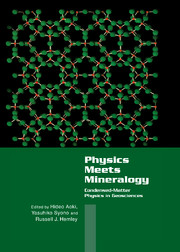Book contents
- Frontmatter
- Contents
- Preface
- List of Contributors
- Part I Introduction
- Part II Advances in Theoretical and Experimental Techniques
- Part III New Findings in Oxides and Silicates
- Part IV Transformations in Silica
- Chapter 4.1 Polymorphism in Crystalline and Amorphous Silica at High Pressures
- Chapter 4.2 Shock-Induced Phase Transitions of Rutile Structures Studied by the Molecular-Dynamics Calculation
- Chapter 4.3 Lattice Instabilities Examined by X-ray Diffractometery and Molecular Dynamics
- Chapter 4.4 Effect of Hydrostaticity on the Phase Transformations of Cristobalite
- Part V Novel Structures and Materials
- Part VI Melts and Crystal–Melt Interactions
- Subject Index
- Materials Formula Index
- Index of Contributors
Chapter 4.3 - Lattice Instabilities Examined by X-ray Diffractometery and Molecular Dynamics
Published online by Cambridge University Press: 05 November 2011
- Frontmatter
- Contents
- Preface
- List of Contributors
- Part I Introduction
- Part II Advances in Theoretical and Experimental Techniques
- Part III New Findings in Oxides and Silicates
- Part IV Transformations in Silica
- Chapter 4.1 Polymorphism in Crystalline and Amorphous Silica at High Pressures
- Chapter 4.2 Shock-Induced Phase Transitions of Rutile Structures Studied by the Molecular-Dynamics Calculation
- Chapter 4.3 Lattice Instabilities Examined by X-ray Diffractometery and Molecular Dynamics
- Chapter 4.4 Effect of Hydrostaticity on the Phase Transformations of Cristobalite
- Part V Novel Structures and Materials
- Part VI Melts and Crystal–Melt Interactions
- Subject Index
- Materials Formula Index
- Index of Contributors
Summary
X-ray diffractometry and molecular dynamics calculation examine the existence of lattice instabilities under the condition of homogeneous or inhomogeneous stress. The atomic positional displacement in each unit cell and fluctuation of the crystallographic translation operation creates lattice deformations that affect both line broadening and diffraction intensities. Pressure-induced amorphization is attributed to these lattice instabilities. Reversible and irreversible pressure-induced amorphization comes about from elastic deformation, and irreversible amorphization is caused by plastic deformation. These amorphous states are precursors to some equilibrium phase transformations.
Introduction
Much attention has been paid to the following phase changes of Earth interiors under high pressure and temperature; (1) phase transformation (transition, melt, amorphization); (2) decomposition, (exsolution, dissociation, phase separation); (3) chemical reaction (solid–solid, solid–molten salt); (4) electronic changes, (electronic excitation, charge transfer, high–low spin state). Many of these changes are associated with lattice instabilities accompanied by changing pressure and/or temperature conditions.
Pressure-induced phase transformation including amorphization is a significant subject not only for phase transition but also for high-pressure studies of industrial materials. Pressure-induced amorphizations of H2O (Ih) and Sio2 were previously regarded as thermodynamically metastable phases, which correspond to the supercooled liquid phase at room temperature [1, 2]; since these discoveries, several crystalline substances have been found to transform into amorphous states under compression at sufficiently low temperatures (Table 4.3.1). Some retain the amorphous state on the release of pressure to ambient, (i.e., showing an irreversible behaviour).
- Type
- Chapter
- Information
- Physics Meets MineralogyCondensed Matter Physics in the Geosciences, pp. 225 - 241Publisher: Cambridge University PressPrint publication year: 2000



